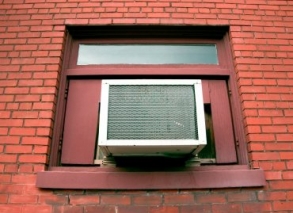Buying Air-Conditioning

- Make the measurements – Measure the size of the room that you are trying to cool, and realize that the frosty air will not snake around corners or through doors. Also, measure the window to make sure you buy a unit that fits.
- Do the math on Btus – Every unit will have a “Btu” rating that corresponds to how many square feet it can cool efficiently. After you’ve measured the space, use this chart to determine your Btu requirements
- Look for Energy Star products – Contributing to global warming in order to cool yourself down seems a bit backwards, doesn’t it? Minimize your energy expentiture (and bill) by getting Energy Star products and budgeting your AC usage wisely.
- Installation – If the store charges an arm and a leg for installation and you aren’t the “following directions” type, see if your super will help you out (and be sure to tip generously).
- Clean frequently – Being cool is great, but blasting dirty, dusty air into your apartment can lead to allergies and sickness. Get a unit with an easily removable filter and clean it once a month.
Memorial Day has passed and, like clockwork, it has become hot and borderline uncomfortable in New York. If summer hasn’t hit your neck of the woods yet, it probably will soon. So how do you avoid annoying situations such as feeling dehydrated and not being able to wear the boxers you slept in? Hook up some
air-conditioning, of course.
If you are lucky enough to live in a house or apartment with AC, then your only real concern should be budgeting your usage so that you don’t rack up an enormous energy bill. Blasting it for 12 hours just so that you can experience that feeling of stepping into an ice box at the end of the work day is simply egregious.
For those of us living in a leased spot sans-AC, spending thousands of dollars installing a central cooling system is clearly not in the cards. If you can't find a gaggle of pretty young things to swarm you with hand fans as you slumber, you're probably going to want to look into a window air-conditioning unit. Here's what you need to know before making a purchase.
Measure the room AND the window
As we’ve discussed before with mattresses and TVs, the lion’s share of the decision-making process for a copping an AC unit comes down to taking some simple measurements. Measure the width and length of the room and multiply to figure out the square footage of the space you want to cool. This will be essential in determining the strength that you require (see below). If two or more rooms are open plan, you’ll want to include the whole space in your measurement. However, the cool air will not go around corners, so if you put the unit in the living room don’t expect it to make much of a difference in your bedroom down the hall (or even next to the window where you install the AC unit). You also need to measure the window to make sure the unit will actually fit—all models will tell you the maximum and minimum dimensions. Ignoring these preliminary measurements could literally be disastrous.
Mind your Btus (and EER)
There’s a magic little number in the world of air-conditioning and it’s measured in Btus (British Thermal Units), the international measure of energy. There is some “science” behind this but suffice to say that the Btu is measurement that determines how efficiently the unit will cool a room. A higher Btu rating means the unit will be bigger, more expensive, and more powerful. Once you’ve measured the space, use this chart to determine your Btu requirements. (Alternatively, you can get a good ballpark figure by just multiplying the square footage by 35.) As mentioned before, base your calculation on the immediate room being cooled, not your whole apartment or a group of rooms connected by doors. Furthermore, don’t make the common mistake of assuming that you should just opt for more Btus than you need. It’s all about efficiency, not sheer power—going too high will result in an uncomfortably cold room.
Once you’ve determined the Btu you’re pretty much ready to hit the marketplace, but it’s also advisable to have a simple understanding of EER (Energy Efficiency Ratio). Divide the Btu by the number of watts used and, bob’s your uncle, you’ve got the EER. It’s going to be somewhere between 8.5 and 11; the higher the EER, the more the unit will cost. There are basically only three reasons you would want to go north of a 10: (1) You want to use your AC unit for several years and plan to use it a lot (i.e., you live in a place that’s hot a decent amount of the year and you spend a lot of time at home), (2) You live in a place that is mad hot, or (3) You are proactive enough to figure out how much you’ll save on your energy bill by shelling out for a more efficient unit.
For a good breakdown of AC-related terms, check out Lowes’ Air Conditioner Buying Guide.
Decide what type of unit you want (and determine your price range)
More than likely, you’re going to get a window unit. But just so you’re aware of the options and price ranges, SoYouWanna has a good breakdown of the three main types of air-conditioning and their respective price ranges. Here’s a summary:
- Window unit: The standard kind you stick in any normal double-hung window. Should have multiple settings. These are what this survival guide is all about. Approx. $250-800.
- Built-in window The fancier, more expensive kind that can go in the window or right into the wall. Usually has more settings, offers heat as well as AC, and uses more energy. Approx. $500-800.
- Split-system Has an outside air-compressor unit that cuts down on noise. Maybe worth looking into if you're putting it in your bedroom and you're a sensitive sleeper. Approx. $300-1000.
In reality, you could find a window unit for anywhere from $100 to well over $1000. If you have a strict budget, go for what you can afford. If you’re flexible, use the discussion above about Btu and EER (the main determinants of price), as well as other “bells and whistles,” to decide how much you should spend.
Choose your features
There are all types features you can find on window units, but here are the ones that matter:
- Warranty: One year is standard, and you may be able to purchase an extended warranty if you’re the cautious type.
- Temperature increments: Make sure you have maximum control over the temperature—you should be able to move the thermostat up and down by increments of 1 degree Fahrenheit.
- Temperature range: Make sure it goes as low as you want it to.
- Settings: Again, you want as much control as possible over fan speed settings and energy-saving options. A timer is ideal so that you can stay cool while you fall asleep but not have to leave it on all night.
- Air filter: See “Maintenance” below.
Where to buy
Any home appliance store will probably have a wide range of sizes and price levels—check out Lowes, Home Depot, and Bed Bath & Beyond. You can also go to Amazon, or even try your luck on Craigslist.
Installation
Are you the D.I.Y. type? Were you good at building model airplanes and Ikea furniture? In that case, you can probably install a window unit yourself in about 30 minutes. However, bear in mind that you may need to purchase some wood to even out the window ledge (there will be instructions for this). If you’re lazy or inept (like me), you can hire someone on Craigslist to come install it for you, pay an installation fee (depending on where you purchase the unit), or ask your super to do it for you. If you’re on good terms with your super and there are no rules against window AC units, that’s probably the best bet—just be sure to give him a tip ($20-50) since it’s beyond the strict definition of his job description. Proper installation is key because any gaps will make the unit less efficient, and if it falls out the unit you might a Clue situation on your hands: “Mrs. Johnson in the courtyard with an air-conditioning unit—crushed!”
Maintenance
AC units build up some gross dust and grime in the filter, and you definitely don’t want to be piping dirty air into your room. Choose a unit with an easy-to-clean filter—one that slides out (rather than being enclosed in a frame) is ideal. Take it out before each cooling season and then clean once a month when you’re using it frequently. How Stuff Works suggests using a mixture of mild household detergent and water. Beyond that, just make sure other windows and doors in the room are closed and the edges around the unit are well sealed. As noted with regards to central cooling systems, budget your usage wisely and don’t leave it blasting on high when you leave the house for the day.
And there you have it: Sayonora, swamp ass!






Comments
(0)POST YOUR COMMENT